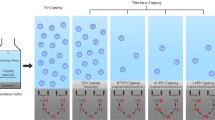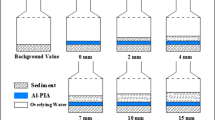Abstract
In this article, dynamic simulation experiments have studied the effects of three capping materials, quartz sand (QS), aluminum-based phosphorus-locking agent (Al-PIA), and lanthanum-modified bentonite (LMB) in reducing phosphorus load in eutrophic water bodies. The changes of various forms of phosphorus in Al-PIA and sediment before and after the test were analyzed, and the mechanism of phosphorus migration and transformation in different capping systems was described. The dynamic simulation test lasted 95 days. The results showed that when the initial concentration of total phosphorus (TP) was 3.55 mg/L, the capping strength was 2 kg/m2 and the hydraulic retention time of water circulation was 0.5 days, indicating that the average reduction rates of TP by LMB, Al-PIA and QS systems were 74.66%, 69.54%, and 3.64%, respectively, compared with the control system. The analysis of variance showed that there were significant differences (P < 0.05) in the TP concentration of the overlying water between the LMB, Al-PIA capping system, and the control system. Lanthanum ions in LMB can fix phosphorus. Al-PIA reduces the phosphorus concentration in water by means of ion exchange, adsorption, complexation, etc. LMB and Al-PIA promoted the migration of phosphorus in sediment. Among them, the phosphorus fixed by Al-PIA was mainly in the form of non-apatite inorganic phosphorus (NAIP) in inorganic phosphorus (IP), which can be seen; Al-PIA can effectively reduce the phosphorus load of eutrophic water.





Similar content being viewed by others
Availability of data and materials
The datasets used and analyzed during the current study are available from the corresponding author on reasonable request.
References
Copetti D, Finsterle K, Marziali L, Stefani F, Tartari G, Douglas G, Reitzel K, Spears BM, Winfield IJ, Crosa G, D’Haese P, Yasseri S, Lürling M (2016) Eutrophication management in surface waters using lanthanum modified bentonite: a review. Water Res 97:162–174
Ding S, Sun Q, Chen X, Liu Q, Wang D, Lin J, Zhang C, Tsang DCW (2018) Synergistic adsorption of phosphorus by iron in lanthanum modified bentonite (Phoslock®): new insight into sediment phosphorus immobilization. Water Res 134:32–43
Dithmer L, Lipton AS, Reitzel K, Warner TE, Lundberg D, Nielsen UG (2015) Characterization of phosphate sequestration by a lanthanum modified bentonite clay: a solid-state NMR, EXAFS, and PXRD study. Environ Sci Technol 49:4559–4566
Fan Y, Li Y, Wu D, Li C, Kong H (2017) Application of zeolite/hydrous zirconia composite as a novel sediment capping material to immobilize phosphorus. Water Res 123:1–11
Hou Q, Meng P, Pei H, Hu W, Chen Y (2018) Phosphorus adsorption characteristics of alum sludge: adsorption capacity and the forms of phosphorus retained in alum sludge. Mater Lett 229:31–35
Huang T, Zhou Z, Su J, Dong Y, Wang G (2013) Nitrogen reduction in a eutrophic river canal using bioactive multilayer capping (BMC) with biozeolite and sand. J Soil Sediment 13:1309–1317
Huang T, Zhou R, Xia C, Xu J (2014) Effects of oxidation-reduction potential and microorganism on the release of phosphorus from sediment. Environ Chem 33:930–936
Ippolito JA, Barbarick KA, Elliott HA (2011) Drinking water treatment residuals: a review of recent uses. J Environ Qual 40:1–12
Kaiserli A, Voutsa D, Samara C (2002) Phosphorus fractionation in lake sediment – lakes Volvi and Koronia. N Greece Chemosphere (oxford) 46:1147–1155
Le Moal M, Gascuel-Odoux C, Ménesguen A, Souchon Y, Étrillard C, Levain A, Moatar F, Pannard A, Souchu P, Lefebvre A, Pinay G (2019) Eutrophication: a new wine in an old bottle? Sci Total Environ 651:1–11
Lei P, Zhang H, Wang C, Pan K (2018) Migration and diffusion for pollutants across the sediment-water interface in lakes: a review. J Lake Sci 30:1489–1508
Li Z, Jiang N, Wu F, Zhou Z (2013) Experimental investigation of phosphorus adsorption capacity of the waterworks sludges from five cities in China. Ecol Eng 53:165–172
Li S, Zhou Z, Yang S, Liu S, Li F, Yuan B (2019) The efficiency of controlling the phosphorus release from the sediment using calcined modified water purification plant sludge ( C-WTPS). J Lake Sci 31:961–968
Lin J, Qiu P, Fan H, Xu Y, Wang G, Xiong X, Jin X, L J, (2016) Effects of in-situ chemical remediation on phosphorus and nitrogen in sediment-water system. Environ Sci Technol 39:271–276
Liu Q, Zhou Z, Zhang H, Fei X, Xie B, Li S, Yuan B (2018a) Parameter optimization of preparing phosphorus removal material by using calcined water treatment plant sludge. J Huaqiao Univ (natural Sci) 39:51–56
Liu Q, Zhou Z, Zhang H, Fei X, Xie B, Li S, Yuan B (2019) Phosphorus removal characteristics of calcined water treatment plant sludge. Environ Chem 38:325–333
Liu Y, Li D, Li X, Song X, Han F, Zhou J (2018b) Distribution of internal phosphorus and its response to disturbance in the Beijing-Hangzhou Grand Canal (Suzhou section). Acta Sci Circumst 38:125–132
Lu J, Liu H, Zhao X, Jefferson W, Cheng F, Qu J (2014) Phosphate removal from water using freshly formed Fe–Mn binary oxide: adsorption behaviors and mechanisms. Colloid Surface A 455:11–18
Okuda T, Nishijima W, Sugimoto M, Saka N, Nakai S, Tanabe K, Ito J, Takenaka K, Okada M (2014) Removal of coagulant aluminum from water treatment residuals by acid. Water Res 60:75–81
Petterson K (1998) Mechanisms for internal loading of phosphorus in lakes. Hydrobiologia 373(374):21–25
Ruban V, López-Sánchez JF, Pardo P, Rauret G, Muntau H, Quevauviller P (1999) Selection and evaluation of sequential extraction procedures for the determination of phosphorus forms in lake sediment. J Environ Monitor 1:51–56
Rui X, Zhang M, Mortimer R, Gang P (2017) Enhanced phosphorus locking by novel lanthanum/aluminum-hydroxide composite: implication for eutrophication control. Environ Sci Technol 51:3418–3425
S Ndergaard M., Windolf J., Jeppesen E (1996) Phosphorus fractions and profiles in the sediment of shallow Danish lakes as related to phosphorus load, sediment composition and lake chemistry. Water Res. 30, 992-1002
Spears BM, Maberly SC, Pan G, Mackay E, Bruere A, Corker N, Douglas G, Egemose S, Hamilton D, Hatton-Ellis T, Huser B, Li W, Meis S, Moss B, Lürling M, Phillips G, Yasseri S, Reitzel K (2014) Geo-engineering in lakes: a crisis of confidence? Environ Sci Technol 48:9977–9979
Tu L, Jarosch KA, Schneider T, Grosjean M (2019) Phosphorus fractions in sediment and their relevance for historical lake eutrophication in the Ponte Tresa basin (Lake Lugano, Switzerland) since 1959. Sci Total Environ 685:806–817
Waajen G, van Oosterhout F, Douglas G, Lürling M (2016) Management of eutrophication in Lake De Kuil (The Netherlands) using combined flocculant – lanthanum modified bentonite treatment. Water Res 97:83–95
Wang C, Bai L, Pei Y (2013a) Assessing the stability of phosphorus in lake sediment amended with water treatment residuals. J Environ Manage 122:31–36
Wang C, Liang J, Pei Y, Wendling LA (2013b) A method for determining the treatment dosage of drinking water treatment residuals for effective phosphorus immobilization in sediment. Ecol Eng 60:421–427
Wang C, Gao S, Pei Y, Zhao Y (2013c) Use of drinking water treatment residuals to control the internal phosphorus loading from lake sediment: laboratory scale investigation. Chem Eng J 225:93–99
Wang C, Wu Y, Wang Y, Bai L, Jiang H, Yu J (2018) Lanthanum-modified drinking water treatment residue for initial rapid and long-term equilibrium phosphorus immobilization to control eutrophication. Water Res 137:173–183
Wang CH, Pei YS (2011) Characteristics of orthophosphate adsorption on ferric-alum residuals (FARs) from drinking water treatment plant. Environ Sci 32:2371–2377
Wang J, Fu Z, Qiao H, Liu F (2019) Assessment of eutrophication and water quality in the estuarine area of Lake Wuli, Lake Taihu, China. Sci Total Environ 650:1392–1402
Wang R, Li D, Huang Y, Liu Y, Chen J (2015) Development of sediment micro-interface under physical and Chironomus plumosus combination disturbance. Environ Sci 36:4112–4120
Wu T, Qin B, Brookes JD, Yan W, Ji X, Feng J (2019a) Spatial distribution of sediment nitrogen and phosphorus in Lake Taihu from a hydrodynamics-induced transport perspective. Sci Total Environ 650:1554–1565
Wu Y, Wen Y, Zhou J, Wu Y (2014) Phosphorus release from lake sediment: effects of pH, temperature and dissolved oxygen. Ksce J Civ Eng 18:323–329
Wu Z, Wang S, Ji N (2019) Phosphorus (P) release risk in lake sediment evaluated by DIFS model and sediment properties: a new sediment P release risk index (SPRRI). Environ Pollut 255:113279
Yang Y, Zhao Y, Babatunde A, Wang L, Ren Y, Han Y (2006) Characteristics and mechanisms of phosphate adsorption on dewatered alum sludge. Sep Purif Technol 51:193–200
Yin H, Wang J, Zhang R, Tang W (2019) Performance of physical and chemical methods in the co-reduction of internal phosphorus and nitrogen loading from the sediment of a black odorous river. Sci Total Environ 663:68–77
Zhan Y, Yu Y, Lin J, Wu X, Wang Y, Zhao Y (2020) Assessment of iron-modified calcite/zeolite mixture as a capping material to control sedimentary phosphorus and nitrogen liberation. Environ Sci Pollut R 27:3962–3978
Zhou Z, Huang T, Yuan B (2016) Nitrogen reduction using bioreactive thin-layer capping (BTC) with biozeolite: a field experiment in a eutrophic river. J Environ Sci 42:119–125
Zhou Z, Liu Q, Li S, Li F, Zou J, Liao X, Yuan B, Sun W (2018) Characterizing the correlation between dephosphorization and solution pH in a calcined water treatment plant sludge. Environ Sci Pollut R 25:18510–18518
Zhu B, Li S, Lin C, Liu S, Zhou Z (2021) The effect of secondary capping on the control of phosphorus release from sediment by activated thin-layer capping with Al-PIA. Environ. Sci. Pollut. R. 1
Funding
This work is supported by the National Natural Science Fund of China (Grant No. 51878300), the Natural Science Foundation of Fujian Province of China (Grant No. 2019J01052), and the Science and Technology Project Foundation of Xiamen City (Grant No. 3502Z20203044).
Author information
Authors and Affiliations
Contributions
Zhenming Zhou received support from the funding. Zhenming Zhou conceived and designed the study. Yichao Wang and Shuwen Li performed eligibility screening and data extraction. Yichao Wang analyzed the data and performed the statistical analysis, as well as wrote the initial manuscript. Shupo Liu and Fei Li critically revised the manuscript.
Corresponding author
Ethics declarations
Consent to participate
Informed consent was obtained from all individual participants included in the study.
Consent for publication
The participant has consented to the submission of the case report to the journal.
Competing interests
The authors declare no competing interests.
Additional information
Responsible Editor: Philippe Garrigues
Publisher's note
Springer Nature remains neutral with regard to jurisdictional claims in published maps and institutional affiliations.
Rights and permissions
About this article
Cite this article
Wang, Y., Li, S., Liu, S. et al. Three kinds of active thin-layer capping materials for reducing the phosphorus load in eutrophic water body: comparison in dynamic experiment. Environ Sci Pollut Res 29, 16427–16435 (2022). https://doi.org/10.1007/s11356-021-16981-x
Received:
Accepted:
Published:
Issue Date:
DOI: https://doi.org/10.1007/s11356-021-16981-x




